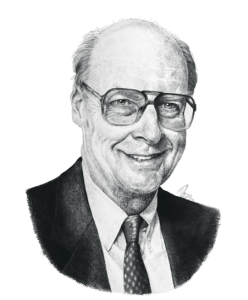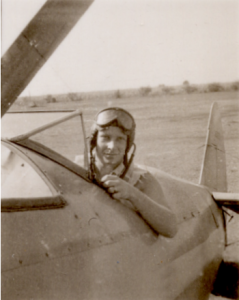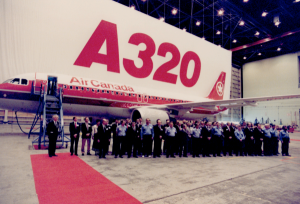Bruce Aubin

Birth Date: March 1, 1931
Birth Place: Montreal, Quebec
Year Inducted: 2025
For his life-long commitment to the advancement of aviation and the safety of aviation in Canada, in a career that included many decades with Air Canada, Bruce Aubin was inducted into Canada’s Aviation Hall of Fame in 2025.
Bruce Aubin has dedicated over seventy years of his life to the advancement of aviation technology, safety, and education in Canada and internationally.
Born in 1931, Bruce’s interest in aviation began early, after he was given a toy airplane as a child. His future leadership skills were evident when he became a member of the Canadian Officers Training Corps at sixteen. At Montreal’s Loyola High School, he was also one of two students awarded the school’s “All Activity Letter” for excellence and participation over four years as well as earning a scholarship for college. Because of his innate passion and aptitude for aviation, Bruce put that scholarship to use towards a bachelor’s degree in Aeronautical Engineering from the University of St. Louis, Missouri; he would go on to obtain several aviation licenses (FAA Multi- Engine Commercial Pilots, FAA Aircraft and Powerplant) and certifications. Indeed, his academic pursuits continued throughout his career, including post-graduate studies in Propulsion Engineering at McGill University, Accident Investigation at the University of Southern California, and a Diploma in Management from McGill University.

Rooted in Transportation
Bruce’s career began in 1951 with Canadian Car & Foundry, where he worked as a structures engineer on Harvard aircraft. He was soon promoted to Chief Structures Engineer. Not long after, Bruce applied to and was hired by Trans-Canada Air Lines, which later became Air Canada. As Senior Structures engineer in the company’s engineering department, Bruce worked extensively on Canadair North Stars and Lockheed 1049C Constellations, developing repairs and modification at a time when these were the prerogative of the airline and approval by the Regulatory Authority. He steadily rose through the ranks, taking on increasingly significant roles, including Project Engineer and Program Manager, which saw him working on or overseeing projects related to the airline’s first jet powered aircraft the, Douglas DC-8 and DC-9 and Vickers Vanguard.
Bruce continued to take on increasing responsibility, first as Maintenance Planning Director in the early 1970s. He was delegated in 1972 to the company’s Canadian consulting organization, CANAC (Canadian National and Air Canada), to assist with establishing national airlines in Tanzania and the Democratic Republic of Congo. From Maintenance and Planning, Bruce was made Director of Maintenance Engineering, and, beginning in 1977, General Manager of Engineering. Four years later, he was made Vice President, Purchasing and Supply. After another four years, he was appointed Vice President of Facilities and Supply.
Concurrently his responsibilities included time as a Director and as President of the Air Canada subsidiary MATAC Cargo Ltd., after which Bruce was appointed Senior Vice President, Technical Operations and Chief Technical Officer for Air Canada in 1989. In this capacity, he managed a half $billion budget and an organization of more than 4,000 people. The position saw him pioneer the role of Chief Technical Officer for the airline, overseeing the entire spectrum of maintenance, engineering, supply chain management (another of his innovations at the company), and facilities – all of which ensured a unified focus on Air Canada’s technical standards and safety practices.
Throughout his career, Bruce was involved with Air Canada introducing sixteen aircraft fleet types and retiring eight others, including the 1049C Super Constellation, Lockheed L1011, and iterations of both the Boeing 747 and 767 aircraft. Bruce was most directly involved with choosing the replacement for the airline’s aging 727s, and led the inter-department selection committee that, after a rigorous fleet replacement evaluation, ultimately recommended purchase of the Airbus A320. This decision helped cement Air Canada’s long-standing relationship with Airbus and maintained its position at the forefront of aviation technology.
Internationally recognized for his expertise, Bruce held leadership positions on numerous industry committees including those under the Air Transport Association (ATA) and International Air Transport Association (IATA). He also chaired several high-profile committees, such as the ATA’s Material Management and Engineering, Maintenance Material committees. His technical advice was sought globally, and he led four ATA All Operators Conferences involving major aircraft manufacturers, including Douglas, Lockheed, and Rolls-Royce.

Semi-Retired
Bruce retired from Air Canada and was elected President of the Society of Automotive Engineers (SAE) in 1993. As head of this storied international standard-setting engineering body (comprising 125,000 members from thirteen nations), he contributed significantly to Standards Development for the automotive industry (automobiles, aircraft, off-highway, etc.) as well as educational outreach and professional development in aerospace engineering. Notably, he played a key role in launching the SAE Foundation Canada and supporting “A World in Motion,” a precursor to the global STEM initiative. The AWIM was provided in both French and English to students in Grades six to twelve across North America and has led to more than 100,000 students towards technical careers. His book, The Art and Science of Keeping Aircraft Safe, was distributed internationally, offering critical insights and guidance into airline maintenance and operations.
Following his term at SAE, Bruce joined US Airways for four years as Senior Vice President of Maintenance Operations, where he was responsible for a team of 8,000 professionals and a budget exceeding $1 billion. He spearheaded the implementation of High Performance Work Organization (HPWO), fostering collaboration between management and unions to enhance maintenance safety and efficiency. His influence helped to improve operational performance and safety across the airline.
Safety has in fact been central to Bruce’s contributions to aviation. He played a critical role in investigating and resolving several major aircraft accidents, including the loss of DC8s in Blainville, PQ and in Ottawa, as well as other major accidents/incidents both in Canada and internationally. He similarly offered legal advice during several investigations, including following the loss of the Air Alaska MD 80 in California and Swissair MD11 in 1998. His recommendations following this work continue to have influence.
In 1969 Bruce was a member of the Industry and Regulatory Task Force, which at the manufacturer’s request developed the first industry standard for the maintenance of new commercial transport aircraft, as well as in-service aircraft. This standard, known as MSG-1, continues in revised editions as the national and international standard in the certification of aircraft. He also developed critical industry operational changes that are in use today: monitored thrust, which provided a method of using required power for take-off of jet aircraft; revisions to annual aircraft weighing, using historic experience and analysis; and the installation of spoiler deployment modifications to aircraft.
Bruce has remained active in aviation in retirement. He chaired the industry exhibition and air show Aerospace North America in 1997. During his time there, he combined its biannual program with the SAE’s technical conference to establish the Aerospace Conference and Exhibition that aimed to broaden SAE’s reach in aviation. In 2003, Bruce joined the Air Canada Pionairs, the airline’s pensioner organization to advocate for its members after the company entered CCAA restructuring. He was soon a Director and volunteer Chairman of the Pension and Benefits Committee, which oversaw and protected the pensions of over 30,000 pensioners. Over his more than a decade with the organization the committee was recognized as the rightful advocate for Air Canada’s pensioners by the airline, the federal Department of Finance, and the Office of the Superintendent of Financial Institutions. In 2006, he helped to found the Canadian Federation of Pensioners to further advocate for broader pension protection in Canada. This work led to passage in 2023 of Bill C228, which granted super-priority status to Defined Benefit pensions in Canada – an achievement that protected over two million pensioners.
Bruce’s many contributions to Canadian aviation have been widely recognized. He is a Fellow of several prestigious institutions, including SAE, the Royal Aeronautical Society, and the Canadian Aeronautics and Space Institute. He received the SAE Medal of Honor in 2002 and delivered the William Littlewood Memorial Lecture in 2003, speaking on the “birth and maturity” of air transport in Canada. In 1987, he was made a member of the prestigious Wings Club and in 2021 was given ‘Golden Eagle’ status. For more than twenty years he has also recognized future leaders through his Bruce Aubin Aerospace Design Award, which he founded in 2002 through the Canadian Academy of Engineering and the Society of Automotive Engineers to honour top students in aerospace design.
With contributions such as these ranging from 1949 through to the 2020s, Bruce Aubin’s life and work is testament to the fact that for him, aviation was not just a career, but a vocation.
2025 Induction Video
To return to the Inductee Page, please click here.
